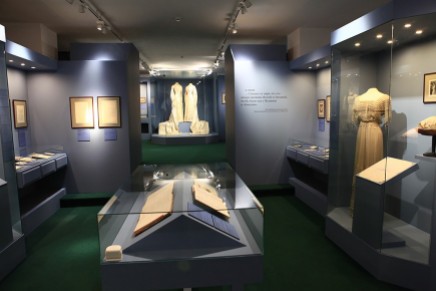Father Vasiliev: Confessor to the Imperial Family
PHOTO: Tsesarevich Alexei Nikolaevich and
Archpriest Alexander Petrovich Vasiliev. Livadia, 1912.
Alexander Petrovich Vasiliev (1868-1918), was an archpriest, tutor to the children of Tsar Nicholas II, confessor of the Imperial Family, and monarchist.
He was born into a peasant family in the village of Shepotovo, Smolensk Province. He was orphaned at an early age. He studied at the school of the famous pedagogue Sergei Aleksandrovich Rachinsky (1833-1902).
After graduating from school, Rachinsky facilitated Vasiliev’s admission to the Belsk Theological School, after which Alexander Petrovich entered the Bethany Theological Seminary, and then the St. Petersburg Theological Academy. In 1893, he graduated with the degree of Candidate of Theology.
While studying at the Academy, he married Olga Ivanovna. The couple had seven children.
On 19th July 1892, he was ordained to the priesthood and sent to St. Nicholas Church, where he served as rector, in the village of Yam-Izhora, Tsarskoye Selo District.
While studying at the Academy, and following the example of his first teacher S.A. Rachinsky, Vasiliev founded a temperance society. The first sermons on sobriety were delivered in the Church of the Righteous Prince Alexander Nevsky at the famous Vargunin paper mill in Maly Rybatskoye, a village located on the southeastern outskirts of St. Petersburg. Alexander Vasiliev’s sermons inspired the Vargunin workers to create a temperance society at the church. The first meeting was attended by 60 people, the second attracted 146 people.
In May 1894, he was transferred to the Church of the Presentation of the Lord in Polyustrovo, and from 7th September of the same year he combined his service in Sretensky Church with the rectorship of the Church of the Exaltation of the Holy Cross at the Holy Cross Community of Sisters of Mercy
PHOTO: Tsesarevich Alexei Nikolaevich with his tutors among others . . . from left to right: Assistant Chief of the Palace Police, Colonel N.P. Shepel; Alexei’s “sailor-nanny” A.E. Derevenko; French tutor Pierre Gilliard; Tsesarevich Alexei Nikolaevich; Russian language and literature tutor Pyotr Petrov and Archpriest Alexander Vasiliev. Spala 1912.
In 1910, Father Alexander was appointed spiritual father and tutor to the children of Emperor Nicholas II and Empress Alexandra Feodorovna.
According to eyewitnesses, members of the Imperial Family were very fond of the divine services performed by Father Alexander Vasiliev.
In his memoirs, Protopresbyter Georgy Ivanovich Shavelsky (1871-1951) reflected on Fr. Alexander Vasiliev: “Before his appointment to the Imperial Court, he enjoyed fame in St. Petersburg as an excellent public preacher, a practical teacher of law, and a beloved spiritual father. His excellent spiritual qualities, kindness, sympathy, simplicity, honesty, zeal for carrying out God’s work, and affability endeared him to both his disciples and his flock. …”
In 1913, he became an archpriest and first rector of the Feodorovsky Sovereign Cathedral in Tsarskoye Selo. In 1914, he was appointed as confessor to the Imperial Family.
He took an active part in the right-wing monarchist movement; in 1910 he was elected a member of the Russian People’s Union of the Archangel Michael (RNSMA). He attended the opening of the Conference of Monarchists, held in Petrograd on 21-23 November 1915.

PHOTO: Archpriest Alexander Vasiliev in
Fedorovsky Gorodok in Tsarskoye Selo. 1916.
In 1915, through the efforts of Father Alexander, a wooden church was built at the Tsarkoselskoye Brethren Cemetery, where soldiers of the Tsarskoye Selo garrison and soldiers who died in the hospitals of Tsarskoye Selo were buried.
On 7th September 1916, his son Sergei Alexandrovich, an officer of the Pavlovsk Regiment, died at the Front. Out of sympathy for her spiritual father’s grief, Empress Alexandra Feodorovna offered to transfer his other sons from combat units to the rear, but he refused, but his son’s death undermined his health.
Following the February 1917 Revolution and the abdication of Emperor Nicholas II, the head of the new Provisional Government Alexander Kerensky (1881-1970) decided to send the Imperial Family into exile to Siberia.
On the evening before their departure, Archpriest Alexander Vasiliev served a parting moleben before the Znamensky Icon of the Mother of God. With the departure of the Imperial Family to Tobolsk, the priest’s health began to deteriorate noticeably, and he began to experience severe pain in the heart.
In early 1918, he was appointed rector of the Church of St. Catherine the Great Martyr in Yekateringof. The monumental 5-domed church featured an altar and two side-chapels: the northern one dedicated to the Martyr Alexandra and the southern one to St. Nicholas the Wonderworker. The iconostasis was made by the Novgorod iconographer Chistyakov. The bell tower was built according to the project of the architect Vasily Dorogulin in 1871-1873. The church was destroyed by the Soviets in 1929.
On 29th August 1918, Father Alexander Vasiliev was arrested by the Cheka in Petrograd. On 5th September – the first day of the Red Terror – Archpriest Alexander Vasiliev was shot by a Bolshevik firing squad, along with the clergy of St. Catherine’s Church. Like so many victims of Lenin’s Red Terror, Vasiliev’s remains were most likely thrown into an unmarked mass grave and forgotten.
Memory Eternal! Вечная Память!
© Paul Gilbert. 29 April 2024










































































You must be logged in to post a comment.